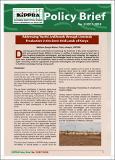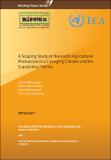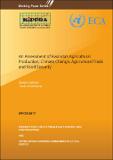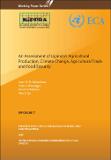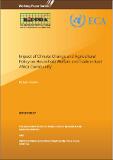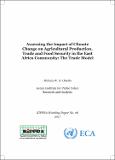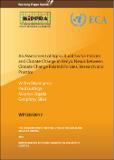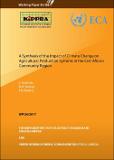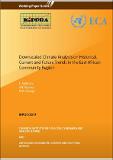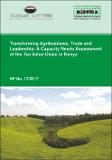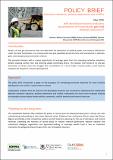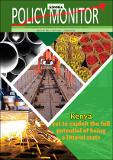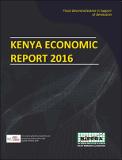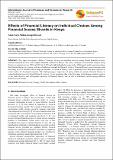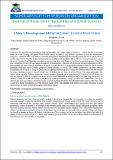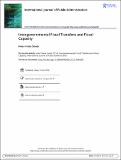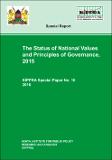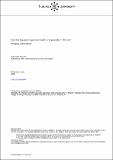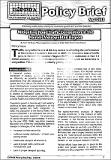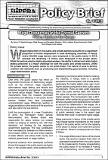3. KIPPRA Research Publications: Recent submissions
Now showing items 381-400 of 708
-
Policy Brief No. 02 of 2017-2018 on Addressing Youth Livelihoods through Livestock Production in the Semi-Arid Lands of Kenya
(The Kenya Institute for Public Policy Research and Analysis (KIPPRA), 2017)Declining agricultural productivity is threatening the livelihood of the youth households in arid and semi-arid lands (ASALs) in Kenya. In addition to limited access to land, use of poor livestock production technologies, ... -
Working Paper No. 24 of 2017 on a Scoping Study on Burundi's Agricultural Production in a Changing Climate and the Supporting Policies
(The Kenya Institute for Public Policy Research and Analysis (KIPPRA), 2017)Climate change will impact on agricultural production and productivity around the world and the agricultural sector will have to adapt to climate change in order to achieve global food security. The general consensus among ... -
Working Paper No. 23 of 2017 on an Assessment of Rwanda's Agricultural Production, Climate Change, Agricultural Trade and Food Security
(The Kenya Institute for Public Policy Research and Analysis (KIPPRA), 2017)Rwanda is a small, hilly, landlocked country located in Eastern and Central Africa region between Burundi, Uganda, Tanzania and the Democratic Republic of Congo (DRC). It is located 2° south of the Equator in Central Africa ... -
Working Paper No. 25 of 2017 on An Assessment of Uganda's Agricultural Production, Climate Change, Agricultural Trade and Food Security
(The Kenya Institute for Public Policy Research and Analysis (KIPPRA), 2017)Recent research has demonstrated that climate change has potential impact on ecosystems globally, with enormous resultant effects on habitants. Evidence exists from observation over half a century demonstrating extreme ... -
Working Paper No. 27 of 2017 on Impact of Climate Change and Agricultural Policy on Household Welfare and Trade in East Africa Community
(The Kenya Institute for Public Policy Research and Analysis (KIPPRA), 2017)The East Africa Community (EAC) was established to widen and deepen cooperation among the EAC Partner States in, among others, political, economic and social fields for their mutual benefit. One of the ways of reaping the ... -
Working Paper No. 28 of 2017 on Assessing the Impact of Climate Change on Agricultural Production, Trade and Food Security in the East Africa Community: The Trade Model
(The Kenya Institute for Public Policy Research and Analysis (KIPPRA), 2017)The linkage between climate change, trade and food security is important in achieving development at both national and regional level in cases where neighbouring countries have a strong integration framework as is the ... -
Working Paper No. 20 of 2017 on an Assessment of Agricultural Sector Policies and Climate Change in Kenya: Nexus between Climate Change Related Policies, Research and Practice
(The Kenya Institute for Public Policy Research and Analysis (KIPPRA), 2017)Climate change and climate change variability is a threat to food production patterns, thus exacerbating food and nutrition insecurity across Africa. Therefore, tackling poverty, hunger and food security is a priority ... -
Working Paper No. 26 of 2017 on a Synthesis of the Impact of Climate Change on Agricultural Production Systems in the East African Community Region
(The Kenya Institute for Public Policy Research and Analysis (KIPPRA), 2017)Climate change has large influences on agriculture and thus food security, which remains heavily dependent on rainfall over Eastern Africa Community (EAC). This study sought to explore the spatial effects of climate change ... -
Working Paper No. 21 of 2017 on Downscaled Climate Analysis on Historical, Current and Future Trends in the East African Community Region
(The Kenya Institute for Public Policy Research and Analysis (KIPPRA), 2017)Understanding and confidence on climate change and its potential impacts have grown greatly over the last few years. While the evidence for climate change grows stronger, uncertainty prevails over the precise nature of ... -
Special Paper No. 17 2017 on Transforming Agribusiness, Trade and Leadership: A Capacity Needs Assessment of the Tea Value Chain in Kenya
(The Kenya Institute for Public Policy Research and Analysis (KIPPRA), 2017)This report analyses the institutional and human capacities of the tea value chain in Kenya. This is necessitated by the need to initiate transformative actions necessary for enhancing the sub-sector’s productivity and ... -
Policy Brief on Extractive Industries, Political Settlements and Conflict
(The Kenya Institute for Public Policy Research and Analysis (KIPPRA), 2016)Kenya's oil and gas discoveries have coincided with the devolution of political power and resource distribution under the 2010 Constitution. The mining sector has also expanded during this time with investments in titanium, ... -
Policy Monitor, Issue 8 No. 2, January-June 2016 on Improving Public Policy Making for Economic Growth and Poverty Reduction
(The Kenya Institute for Public Policy Research and Analysis (KIPPRA), 2016)In this issue of the Policy Monitor, we take a detailed look at various dynamics in a number of sectors and sub-sec- tors of Kenya’s economy. The first article takes an overview of the macro trends of the economy, considering ... -
Kenya Economic Report 2016 on Fiscal Decentralization in Support of Devolution
(The Kenya Institute for Public Policy Research and Analysis (KIPPRA), 2016)The Kenya Economic Report 2016 is the eighth in a series of annual reports on the Kenyan economy prepared by the Kenya Institute for Public Policy Research and Analysis (KIPPA). The report reviews Kenya’s recent economic ... -
Effects of Financial Literacy on Individual Choices Among Financial Access Strands in Kenya
(International Journal of Business and Economics Research, 2016)This paper investigates effects of financial literacy on individual choices among formal financial services, informal financial services, and complete financial exclusion in Kenya. The study employed cross-sectional analysis ... -
Africa's Development Metamorphosis: Lessons from China
(Scholars Citech Research Organization, 2016)China is a fast-growing world economy that has overtaken the United States of America. Africa has for a long time relied on donor funding and grants from Bretton woods institutions and Western countries to fund its development ... -
Intergovernmental Fiscal Transfers and Fiscal Capacity
(International Journal of Public Administration, 2016)An intergovernmental fiscal transfer is an instrument used by governments to equalize fiscal capacity. However, with the large discrepancies in fiscal capacity among Local Authorities (LAs) in Kenya, it is evident that the ... -
Special Paper No. 16 of 2016 on the Status of National Values and Principles of Governance, 2015 KIPPRA
(The Kenya Institute for Public Policy Research and Analysis (KIPPRA), 2016)The Constitution of Kenya (2010) recognizes that the realization of National Values and Principles of Governance (NV&PG) articulated in Article 10 is essential for national development. Once grounded in all facets of Kenya’s ... -
Can the Big Push Approach End Rural Poverty in Africa? Insights from Sauri Millennium Village in Kenya
(Tilburg University, 2016)The greatest development challenge facing the low-income countries, especially Sub- Saharan African countries, has been making progress towards achieving the Millennium Development Goals (MDGs) by 2015. Sub-Saharan Africa ... -
Mitigating Road Traffic Congestion in the Nairobi Metropolitan Region
(The Kenya Institute for Public Policy Research and Analysis (KIPPRA), 2015)Traffic congestion is one of the key concerns affecting the performance of the transport system in Nairobi. In 2008, the economic cost of traffic jams in Nairobi Metropolitan Region was etimated at Ksh 1.9 Billion annually -
Policy Brief No. 03 of 2015 on Wage Disparities in the Formal Sectors: Policy Options for Kenya
(The Kenya Institute for Public Policy Research and Analysis, 2015)Wage employment in the public and private sectors accounts for a significant proportion of formal employment in most developing countries. In Kenya, nearly 655,000 wage earners were employed in the public sector in ...

